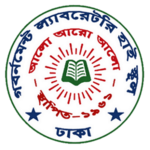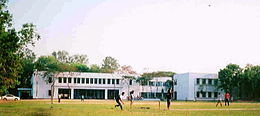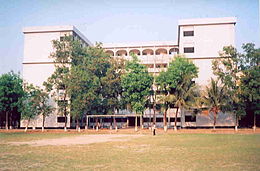MD. Sakibur Rahman (talk | contribs) |
MD. Sakibur Rahman (talk | contribs) |
||
| Line 66: | Line 66: | ||
==Results== |
==Results== |
||
The first examinees attended the [[Secondary School Certificate]] examination from this school in 1964. That year a Government Lab student achieved 4th place in the merit list.<ref>Anushilan: 2002-2003 issue (Page- 158). Retrieved on November 17, 2008.</ref> The highest success came in 1993. That year 27 students from this school had positions on the merit list. They took 17 out of 20 places from the merit list.<ref>Anushilan: 2002-2003 issue (Page- 158). Retrieved on November 17, 2008.</ref> |
The first examinees attended the [[Secondary School Certificate]] examination from this school in 1964. That year a Government Lab student achieved 4th place in the merit list.<ref>Anushilan: 2002-2003 issue (Page- 158). Retrieved on November 17, 2008.</ref> The highest success came in 1993. That year 27 students from this school had positions on the merit list. They took 17 out of 20 places from the merit list. Almost in every year in almost every public examination Government Lab achieves the honor of 100% passing students; Not just passing Government Lab students pass with very good numbers in almost every year.<ref>Anushilan: 2002-2003 issue (Page- 158). Retrieved on November 17, 2008.</ref> |
||
==Co-curricular activities == |
==Co-curricular activities == |
||
Revision as of 14:32, 30 December 2014
| Government Laboratory High School | |
|---|---|
 | |
| Address | |
 | |
1 Naem Road, Dhanmondi, Mirpur Road, Dhaka 1205 | |
| Coordinates | 23°44′9.97″N 90°22′54.15″E / 23.7361028°N 90.3817083°E |
| Information | |
| Type | Public boys school |
| Motto | Alo aro alo {Light, more light(With knowledge)} |
| Established | 3 September 1961 |
| Grades | 1-12 |
| Campus | Urban |
| Color(s) | White and Navy blue |
| Nickname | Laboratorians, Lab, Govt Lab |
| Accreditation | Board of Intermediate and Secondary Education, Dhaka |
| Yearbook | Anushilon |
The Government Laboratory High School is a school located in Dhanmondi, Dhaka, Bangladesh. Govt. Lab. (as it is popularly known) was established on 3 September 1961.[1] The boys' school is a leading public school in the region.
The beginning


The Principal of the nearby Teacher's Training College, Muhammad Osman Gani, sought to establish a facility to assist his trainees practice teaching. From this idea Government Laboratory High School was created. The school was inaugurated in 1961 by the then Director of the Department of Public Instruction(D.P.I), Muhammad Shamsul Haque. The first Headmaster was Khan Muhammad Salek, who went on to serve for 12 years.[2]
Below is a list of the first teachers at the school, upon its opening.[3]
- Khan Muhammad Salek (Headmaster)
- A. B. Mofizuddin Ahmed (Assistant Headmaster)
- Sirazul Haq Khan
- Muhammad Zafar Ali
- Abdur Rashid
- Muhammad Zahirul Huq
- Muhammad Nurul Islam
- A. B. M. Nurul Islam
- Muksedur Rahman Hawladar
- Muhammad Sharifuddin
- Khabir Uddin Ahmed
- Muhammad Waliullah
- Muhammad Sadat Ali
- Sri Suranjan Dutta
Admission
Under the control of ‘Directorate General of Secondary and Higher Education, Dhaka’ admission tests of all the government schools of Dhaka city are taken. The schools are divided into four groups: A, B, C and D. Government Laboratory High School is in group A. Usually students are admitted in class 1, 6 and 9. Admission can be considered in other classes if a vacancy is created. The admission test is taken usually in the first week of January.
Admission in higher secondary level is taken after the publication of S.S.C. result.
Class and section system
When the schools was first planned it was envisaged that study would start from class 3. However, due to eagerness from both Muhammad Osman Gani and Khan Muhammad Salek, classes 1 and 2 were included.[4] During this time classes 9 and 10 were omitted, but were added over the years.
Each class is divided into four sections — 'A', 'B', 'C' and 'D' — But in 2007 admission there were included tho extra sections — 'E' and 'F' — in class 1 for only that year; Because in that year there were more meritorious students than the number of allotted seats for class 1 students. each sections contains 60 students. The students' day is split into two shifts, 'Morning' and 'Day', with two sections(Three sections only for 2007 admission batch) studying in each half of the day.
House culture and tiffin system
The students are grouped into four houses for participation in competitions. The houses are named after four legends which each respresent a human quality: Al Biruni (Scholarship), Al Ma'mun (Good governance), Omar Khayam (Youth) and Salahuddin (Bravery). Each house has a colour; yellow, blue, green and red respectively.[5]
In 1962 a system for distributing tiffin was introduced. Money is deducted from the student's academic fees each month which entitles them to such snacks as singara, samucha, nimki, paratha and bundia or daal, jilapi, chopbun, cake, bananas, bread, eggs and sweets.
Uniform
From years 1 to 3 the uniform is a white shirt with navy blue shorts and white keds. From years 4 to 12 the uniform is a white shirt with full-length navy blue pants and white keds. For all years the school's monogram, which was designed by Zainul Abedin, is printed on the shirt pocket.
Results
The first examinees attended the Secondary School Certificate examination from this school in 1964. That year a Government Lab student achieved 4th place in the merit list.[6] The highest success came in 1993. That year 27 students from this school had positions on the merit list. They took 17 out of 20 places from the merit list. Almost in every year in almost every public examination Government Lab achieves the honor of 100% passing students; Not just passing Government Lab students pass with very good numbers in almost every year.[7]
Co-curricular activities
There are some clubs and organizations to help co-curricular activities. There is Scouting, B.N.C.C. and Red Crescent. The notable clubs are Quiz Club of the Laboratorians (Q.C.L.), Debating Club of the Laboratorians (D.C.L.) and Laboratorian's Science Club (S.C.L).
Library
The library has approximately 7,500 books.[8] Most of them were bought by coeval sanctioned money during the establishment of the school. Others were bought by annually approved money.
School day


The 'birthday' of the school is 3 September. The day is celebrated as the 'school day' and the academic programs are cancelled. Functions are organized in each of the sections. Students decorate their classes with balloons, posters, pictures, colorful papers, and they publish wall magazines which are adorned by the stories, poems and others things of their own. Teachers and guardians admire their works. Students sometimes give invitation letters to their teachers to visit their room. Sometimes a birthday cake is cut celebrating the birthday of the school.
School magazine
The school magazine is Anushilan which was first published in 1963; the editor was Kazi Nurul Huq.[9] The magazine is not published regularly every year.
Headmasters
- Khan Muhammad Salek
- Hafiz Uddin Ahmed
- Zafar Ali Khan
- Md. Zafar Ali
- Muhammad Muhibullah
- Muhammad Nurul Huq Bhuiya
- Muhammad Rabiul Islam Khan
- Muhammad Zahirul Haque
- Muhammad Habibullah Khan
- Muhammad Momtazur Rahman
- Muhammad Abdus Sobhan
- Md. Nasir Uddin
- Rashid Uddin Zahid
- Abul Hasanat Faruq
- Syed Hafizul Islam
- A.K.M. Mostofa Kamal
- Md. Abu Sayeed Bhuiyan
- Md. Abdul Khaleque
Old Laboratorians Association
There is an organization of the ex-students of the school named the Old Laboratorians Association (OLsA). The aim of the organization is mainly to organize reunions amongst the ex-students of this school. Advertisements of OLsA's functions are published through the national dailies and its website.[1]
Gallery
-
Entrance
-
Corridor
-
Space in front of the teacher's room
-
Shaheed Minar
-
Auditorium
References
- ^ Anushilan: 2002-2003 issue (Page- 155). Retrieved on November 17, 2008.
- ^ Anushilan:2002-2003 issue (Page- 155). Retrieved on November 17, 2008.
- ^ Anushilan:2002-2003 issue (Page- 156). Retrieved on November 17, 2008.
- ^ Anushilan: 1998 issue (Page- 266). Retrieved on November 17, 2008.
- ^ Anushilan: 1998 issue (Page- 267). Retrieved on November 17, 2008.
- ^ Anushilan: 2002-2003 issue (Page- 158). Retrieved on November 17, 2008.
- ^ Anushilan: 2002-2003 issue (Page- 158). Retrieved on November 17, 2008.
- ^ Anushilan: 2004-2005 issue (Page- 199). Retrieved on November 17, 2008.
- ^ Anushilan: 2002-2003 issue (Page- 157). Retrieved on November 17, 2008.




